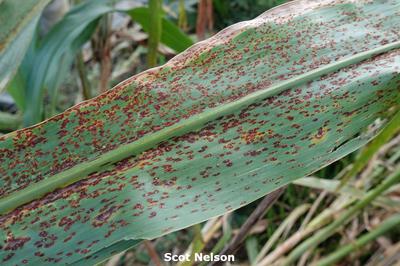Rust of Sorghum
Puccinia purpurea
Fungus
In a Nutshell
- Minute flecks on leaves slowly develop into purplish, slightly raised pustules on the lower surface.
- They are circular to oval in shape, and loosely scattered or in patches.
- Symptoms may also be found on leaf sheath and stalks of inflorescences.
Can also be found in
Symptoms
The symptoms are usually observed in plants aged 1-1.5 months. Minute flecks of different color (purple, tan or red) first appear on lower leaves. In resistant varieties the symptoms develop no further. In susceptible ones, as they fill with spores, the flecks turn into powdery, purplish, slightly raised pustules, circular to elongated in shape. They are loosely scattered or in patches and may darken even further as the plant matures. In highly susceptible cultivars the pustules may cover the entire plant and the infected fields look brown. The pustules may also be found on stalks of inflorescence or leaf sheath.
Recommendations

Organic Control
No alternative treatment against Puccinia purpurea is available so far. Please get in touch with us in case you know of anything that might help to fight this disease. Looking forward to hearing from you.

Chemical Control
Always consider an integrated approach with preventive measures together with biological treatments if available. The application of fungicides can be beneficial when used on susceptible varieties. Products based on hexaconazole (0.1%), difenconazole (0.1 %) and propiconazole (0.1 %) can be used to control the disease. Two sprays of these fungicides at 15 days interval immediately after appearance of symptoms is recommended.
What caused it?
The disease is caused by the Puccinia purpurea, a fungus that survives only short periods of time in soil and infected debris. Therefore, it needs to overwinter in an alternate host such grasses or some weeds, for example the creeping woodsorrel (Oxalis corniculata). The spores can be transported over great distances by winds and rain. The development of the disease is favored by high relative humidities (nearly 100%), dew, rain and cool temperatures (10-12 °C). Hot, dry weather will in turn slow or hinder the development of the fungus and the incidence of the disease. In some cases, withering and destruction of severely infected leaves is possible.
Preventive Measures
- Plant resistant varieties available locally.
- Use healthy seeds from a certified source.
- Do not use seeds from infected fields.
- Plant early in the season to avoid optimal conditions for infection.
- Use shorter season varieties that mature earlier.
- Monitor field for signs of the disease.
- Remove infected plants and destroy them (for example, by burning them).
- Plan a good weed management to avoid cross infection with other host plants.
- Rotate with non-susceptible crops.



